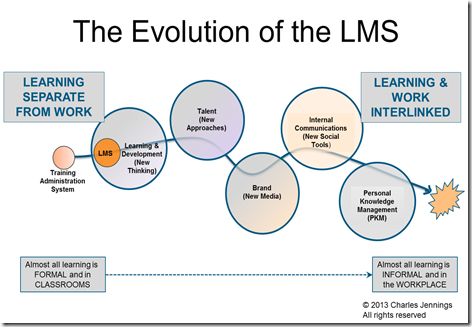 Donald Taylor recently published an article titled ‘What does ‘LMS’ mean today?’. In it Donald posited something I’ve been advocating for years.
Donald Taylor recently published an article titled ‘What does ‘LMS’ mean today?’. In it Donald posited something I’ve been advocating for years.
It is this.
Learning can only be managed by the individual in whose head the learning is occurring.
Of course external factors – such as other people (especially your manager and your team), technology, prevailing culture, general ‘environmental’ factors, and a range of different elements – can support, facilitate, encourage, and help your learning occur faster, better, with greater impact and so on. But they can’t manage the learning process for you. That’s down to you alone.
This raises an important set of challenges. One of which is “if learning is managed by the learner, what will the technologies that support her look like in the next 3, 5, 10 years?”
One thing we know for sure. They won’t look like the learning management systems installed in the vast majority of organisations across the world today. Sadly, many of these meet Marc Rosenberg’s description as ‘course vending machines’.
Keeping the CEO out of Jail
In his article Donald quotes Andy Wooler, Academy Technology Manager at Hitachi Data Systems Academy, as saying:
“LMS too often stands for Litigation Mitigation Service.”
Andy was not dismissing the need for LMSs out-of-hand. He was simply saying that often the technology is used just to keep records in case something goes wrong and there is a need to produce evidence to support the organisation’s case in court – or, hopefully to avoid court altogether. Many organisations – especially those in highly regulated industries – take this view. In the past that strategy provided a more robust defence than it does now (see an earlier article about compliance training for a discussion on that issue). A record that someone had completed a compliance course may have won the day in the past, but is less likely to do so now. However, compliance course completion often has little, if anything, to do with learning and certainly won’t contribute much to building the high-performing cultures every organisation needs to aspire to if it’s to be successful.
A Tool for (a fading) Industrial Society
In his article, Donald also gave a pen-sketch of the origins of the Learning Management System (LMS) as training administration systems.
LMS technology emerged from a need to automate process management and record-keeping systems in the post-World War II era when the focus was on industrialisation and the development of mass production techniques. With millions of returned servicemen and women re-entering education and training there was a need to manage the process of classroom training more efficiently. LMSs appeared alongside the automation of other organisational processes – financial systems and HR management systems (HRMSs).
But LMSs were a step on the road, not an end in themselves.
The management modules of learning technologies such as PLATO (arguably the first LMS) the ‘computer assisted instruction system’ which was conceived and built at the University of Illinois in 1960 (and finally shut down in 2006) were developed to support automated teaching operations (the ‘ATO’ part of the name) in a world where standardisation and automation were the primary goal. They were conceived and developed to primarily solve an organisational problem, not necessarily to improve the learning experience for the individual learner or worker.
We need a lot more, and a lot different, from whichever technologies we select to support the development of our workforce today and into the future
Moving to the Future
The diagram below gives an idea of challenge facing us as we move into a world where learning management is in the hands of each individual and their supporting ecosystem.
In a world where the majority of learning is in the workflow and most of it is ‘informal’ (self-directed or undirected in the moment of need), the idea of pouring large amounts of your organisation’s L&D budget into a concept and technology that was designed to make easier the scheduling of courses and programmes is not a sensible one to take.
Of course we will need technology to support learning. Even more so than ever before. But, as noted earlier, the technology we need is a long stride away from that which most organisations currently have in place.
My colleague Jane Hart has written about this challenge for some years (see here for an article by Jane from 2010). She sees the future of technologies supporting learning as a mash-up of social co-operation and collaboration tools aligned with the emerging social workplace. More importantly, Jane provides advice that L&D can’t sit alone. Learning leaders need to work with their colleagues in IT and Business Operations to get the right tools in place. To that I’d add the need to work with Internal and Corporate Communications colleagues, Brand specialists, Knowledge Management teams as well as your extended value chain.
I think Jane is absolutely correct. The tools that will be used to support (but not manage) learning in the future will principally be drawn not from a learning-centric focus but from other area (although I believe the LMS will live on to support some formal education and may extend to a limited extent to supporting structured experiential learning). Her Top 100 Tools for Learning is probably a good place to start looking.
The Rise of PKM
My diagram above points to PKM (Personal Knowledge Management) as an important emerging area for supporting the learning-work interlink. Harold Jarche has written extensively on PKM and you can download his PKM Whitepaper from here. If you want to learn more about PKM I’d recommend mining Harold’s blog.
There is no doubt that both social learning tools and PKM tools and processes will be vital to support learning management of the future.
However, it’s important to always remind ourselves that any technology can never be more than a supporting actor in the play of building high-performing cultures.
In the end we each manage our own learning to suit our immediate and longer-term needs at our own pace, in our own time, and in our own way.
--------------
(I have written more extensively about the challenge of ‘Managing Learning’ in the 'The Really Useful eLearning Instruction Manual' a book to be published by John Wiley & Sons and edited by Rob Hubbard)
#itashare
